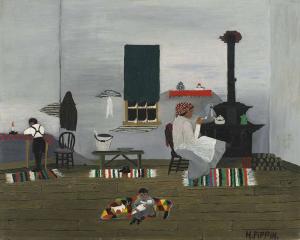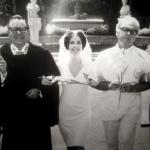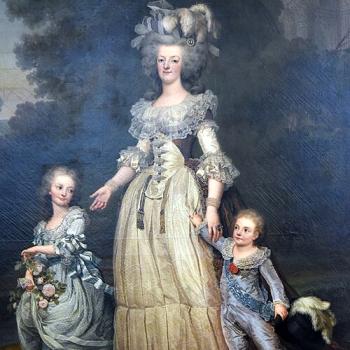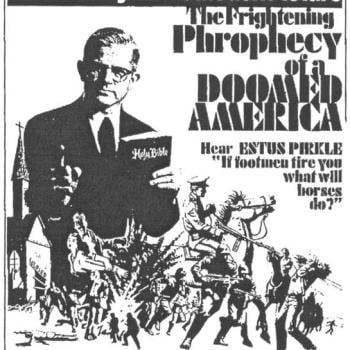
Source: Public Domain
Much to some Baby Boomers’ chagrin, our moment bears comparison with the tumultuous 1960s. Then, as now, Black racial consciousness blossomed, just as Black music and culture became fashionable. We’ve got rioting, a Leftward push rebuffed and domesticated by entrenched power structures, and moral panics around sexual mores. More kids take more drugs more regularly in the face of a hopeless future—many times more powerful than those available in the Decade of Love and Hate (paging Robert Mitchum), but paralleling those groovy times nonetheless.
There exist differences too—today there is no grand war to rally against, the indefatigable hope of the hippies has understandably vanished. Strangely enough, what unites the two moments most might be a difference: the times that separate them. Growing up in the 90s and 2000s, I recall a truce that many (without saying so) took to be an armistice. Non-white characters featured in many shows I watched as a kid (even if they weren’t meant for me); sometimes as tokens, but not always [e.g., The Proud Family (2001-2005), Fillmore! (2002-2004), Jackie Chan Adventures (2000-2005), ¡Mucha Lucha! (2002-2005), Sister, Sister (19934-1999), The Boondocks (2005-2014)]. Similarly, the 70s saw the first wave of inclusion on TV with the likes of The Adventures of Fat Albert and the Cosby Kids (1972-1985), The Jeffersons (1975-1985), Good Times (1974-1979), and Sanford and Son (1972-1979). As much as we might love these shows, they represent a departure from physical politics towards mainstream representation. The questions raised in the 60s faded away; everyone agreed to stop discussing difficult matters of race and identity. We might even say that, despite the first (and now we can see quite small) wave of “political correctness” in the 90s that just briefly interrupted the real language policing afoot—this truce, this agreement mostly acted to suppress major questions and confine racializing and political rambunctiousness to dog whistles and locked rooms.
Thus when one IMDb reviewer from distant 2001 writes the following about Hal Ashby’s The Landlord (1970), befuddlement is not far behind: “I don’t think a film such as this could be pulled off properly now, because there is the constant threat of backlash if things aren’t completely ‘PC.’” November 2001. Admittedly, I was a kid, but I seem to recall a certain terrorist attack in Manhattan and a torrent of uninterrupted prejudice and even violence against Muslims, Arabs, South Asians, and Sikhs. Half the comedies of my childhood proffer a joke about towels worn about heads, virgins in paradise, or the “silly” sound of Arabic (or is that supposed to be Pashto?). That review is right about one thing though: “I was pleasantly surprised with the complexity of ‘The Landlord’. It was brilliantly directed […] I think this film was made at the right time, but it still rings true 31 years later.”
Ashby, already an Oscar-winning editor, debuts as a director with a tour-de-force that—and here’s the twist—could hardly be made today, at least not by a major studio. Its trenchant critique of US racism in general and gentrification in particular indicts Americans in 2023 as much, if not more, than our (fore)fathers in 1970. Most surprising of all for our dour moment, it’s a comedy—directed by a white man, but adapted by a Black man (Billy Gunn) from a novel by a Black woman (Kristin Hunter). Class is never far from the lens, as the intersections of oppression are unsparingly (and by turns lightheartedly and seriously) exposed and explored. The Landlord is not a bid for representation but a compelling account of lived conditions. The poor, high school dropout Ashby could do no other.
The straightforward plot underlines the movie’s direct critique. Elgar Winthrop Julius Enders (Beau Bridges—what’s he named after Edward Elgar?) lives on an allowance from mummy and didi, William (Walter Brooke) and Joyce (Lee Grant). His slothfulness won’t do, however, and, pestered by his parents, E.W.J. Enders calls forth the Protestant Work Ethic from his very marrow and…buys an apartment building in then all Black Park Slope, Brooklyn (non-white Park Slope? What? It’s almost like this movie actually happened!). Being a landlord might be hard work, but—Elgar reasons—it should still allow for some time to loaf. The rest of the movie’s 113-minute runtime traces Elgar’s development from a clueless, passively racist youth to a genuine friend of his tenants. He becomes romantically involved with two Black women (to the horror of William and Joyce) and grasps at, I suppose in the language of our day, how to be the best ally he can be.
I know what you’re thinking. I really do. No, this isn’t a white savior narrative. Elgar couldn’t save an elephant from a mouse. When he first parks in the city, he immediately leaves to grab flowers. The camera waits for him, set low behind a car, its trunk labeled “white,” until he appears at the edge of the frame. His face contorts with shock. We cut to two neighborhood kids taking the hubcaps off Elgar’s (obviously expensive) car. Smart enough to know when the gig’s up, the little rascals scatter, leaving Elgar to drive away defeated.
Abruptly, we’re looking at the newly minted landlord from the hood of his car, his blond hair flapping in the wind above his white suit jacket. The radio blares. He smiles, perhaps amused by what’s happened and pleased that he stopped it before things got too bad. Once parked, he begins to take off his jacket when a neighborhood kid (Douglas Grant) no older than six or seven pops up from the backseat, introducing himself “Walter G. Copee. My name’s Walter G. Are you the new landlord?” “Yeah,“ Elgar stammers, disbelieving. “Hey man give me two dollars.” Naturally, he inquires why he should give Walter G anything, still not realizing that he is playing someone else’s game. “’Because Slickie if you let me hold two dollars, I’ll let you take me home. If not, I’ll call the pigs.” Letting out a brief scream to underline his seriousness, Walter’s stunt leads to Elgar caving. Walter G, triumphant, puts a cigarette in his mouth, turns the music up, and starts dancing in his seat, ending this topsy-turvy encounter by barking “Home, landlord!”
Elgar’s first actual visit to the building inflects just how out of his element he is. Before Elgar even gets through the door, we see in a high-angled shot over his shoulder that kids are finishing the job from earlier; there go the other hubcaps. When he does enter, he’s met with a shotgun barrel and a shout of “hold it there, honkey! […] My horoscope told me evil was coming to my door today. And, Marge, here it is!” This is, of course, Marge (Pearl Bailey), who invites him up for some lunch once she finds out who he actually is. Over the course of the meal, she toys with him, hinting at a rent strike (his jaw about hits the floor) and adding that no one ever paid the old landlord anyway (she reports that the last guy chased a rat into a broom closet and wasn’t found for months).
Suddenly, Fanny (Diana Sands) bursts in to ask if Marge has seen a white man skulking around. We cut to Elgar pulling his unbelted white pants up high, masking half his pink shirt, dumb smile on his face. Behind him are chipped walls, covered in magazine and newspaper pages, photographs, and, directly behind the landlord, a portrait of MLK. Now in a two shot, the camera catches her as she flies into a rage, poking at his chest, asking why he gave her son money for cigarettes. Half-laughing, Elgar counters that it’s her job to watch her kid. “I’m busy frying hair all day, fool!” Unlike Elgar, Fanny has to work “Frying hair?” he shouts with bewilderment. “I don’t see a license for frying hair!” She gasps in mock surprise: a business without a permit—quelle horreur! Once Marge informs her that this is their new landlord, Fanny calms down and, in dulcet tones, offers that he come to her place to “discuss this at length.”
The Black tenants are not perfect though; they are people, human both in the streetwise skills they develop from having to work and hustle for a living, and in their faults. There is cheating, neglect, and crime. Their sins, however, pale in comparison to those of Elgar and his family. One resident, Professor Duboise (Melvin Stewart), chuckles when he thinks the white man is a “pig,” but stares angrily, refuses a handshake, and silently walks away when he finds out the guy’s a landlord. That’s how much damage the Enders and those like them have done, leaving these people in squalor, while they dance on the verandas of their all-white houses, looking out onto the sprawling lawn. Elgar’s family is dysfunctional and unfeeling. His mother is a proto-wine mom who doesn’t know his birthday. His family and friends make passive-aggressive remarks about how he’s finally found some success (read: you’re a black sheep and a loser).
Their rank hypocrisy comes into total focus at a dinner party, at which one guest warns Elgar that he’s bought a house in “a colored neighborhood.” “Colored neighborhood!” shouts another in mock disgust (she’s changing with the times—don’t say the quiet part out loud). With dignified WASP restraint, Mr. Enders squashes the conversation. He won’t hear of the “revolting aspects” of this business venture at the table. Elgar begins to lose it and, in hushed tones, begins to make his sister’s (Susan Anspach) fiancé (Robert Klein) think something is very wrong, that this family is trying too hard not to discuss race. Getting his mark more and more flustered, Elgar gleefully smiles and declares: “we’re all octoroons!” He’s not done. He gestures to the servants standing in the corner: “And here are our dark relations!” Now Elgar’s the one toying with squares.
That outdated term at the end suggests why this might be hard to make today. The Landlord deploys racist terminology for realism, yes. But more than that the movie includes such language to mock and deride racists. White people use the n-word. It also “centers” a white man (mostly to show how pampered and foolish he is, but that might not be enough justification now). I wonder too if the gruff and frank anger the tenants and other Black people feel at white people in general and landlords in particular could be represented in the same way. In parts disgusted and interested the locals can’t take their eyes off Elgar (once in Park Slope, he is the outsider held up as an aberration, gawked at like a chimp at a zoo). We’re more diplomatic now. The language is too raw, unprocessed into our HR-inflected jargon.
Watch the whole thing on YouTube (unfortunately broken down into many shorter videos). You’ll laugh. You’ll cry. You’ll see how little has changed and how much has gotten worse.













